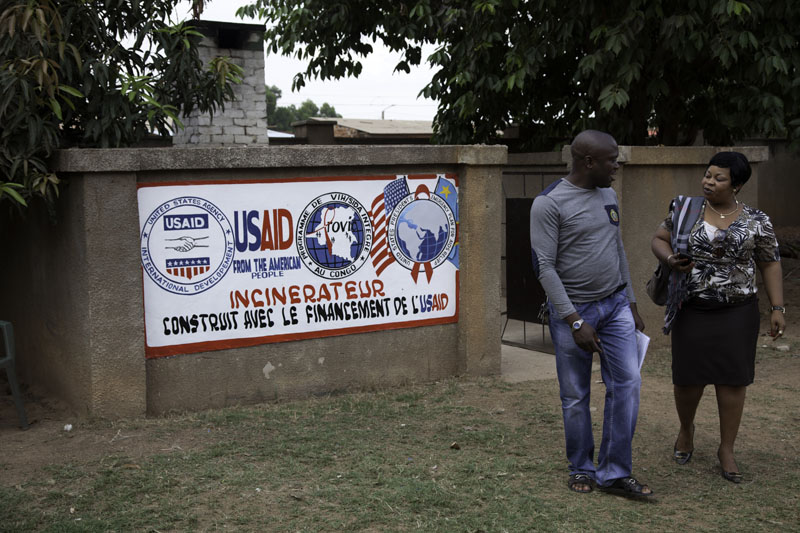Courtney CarsonGHTC
Courtney Carson is a policy and advocacy officer at GHTC, who leads GHTC's US advocacy portfolio.
On Tuesday, the Trump Administration released its full fiscal year 2018 (FY18) budget proposal, “A New Foundation for American Greatness.”
As foretold by the “skinny budget” proposal released in March, this budget proposes dramatic increases in defense spending and border security, offset
by cuts to discretionary spending—including significant cuts to programs that support global health and medical research at the National Institutes
of Health (NIH), Centers for Disease Control and Prevention (CDC), and the US Agency for International Development (USAID).
At a high-level, President Trump proposed roughly a 25 percent cut to global health programs at the State Department and USAID, when compared to final fiscal year 2017 (FY17) funding levels. Looking just at USAID global health programs, funding levels were reduced over 50 percent from FY17 levels, from US$3.05 billion to $1.5 billion. The Administration also used the budget proposal to advance goals of streamlining USAID and State Department operations to find cost savings and efficiencies.
Despite strong bipartisan support for the United States’ flagship global HIV and AIDS program, the President’s Emergency Plan for AIDS Relief (PEPFAR), HIV and AIDS programs across State and USAID were targeted for cuts and consolidation. Direct funding for PEPFAR through the State Department received a $477 million cut, dropping to $3.85 billion from $4.32 billion, and USAID funding for complementary HIV and AIDS programs was zeroed—reflecting a funding cut of $330 million. The zeroing of HIV and AIDS programs at USAID also means associated research and development (R&D) funding for HIV vaccines and microbicides was eliminated.
 Man and woman standing in front of a sign that reads "USAID." (PATH/Felix Masi)Other funding cuts include a $62 million cut to global tuberculosis (TB) programs—including cuts to the TB drug facility and multidrug-resistant
TB financing—a $65 million cut to maternal and child health programs, a $47 million cut to nutrition programs, and a $25 million cut to programs
for neglected tropical diseases. USAID malaria programs (the President’s Malaria Initiative) received an $81 million cut, after factoring in a proposed
$250 million transfer of remaining Ebola funds. USAID family planning programs were eliminated.
Man and woman standing in front of a sign that reads "USAID." (PATH/Felix Masi)Other funding cuts include a $62 million cut to global tuberculosis (TB) programs—including cuts to the TB drug facility and multidrug-resistant
TB financing—a $65 million cut to maternal and child health programs, a $47 million cut to nutrition programs, and a $25 million cut to programs
for neglected tropical diseases. USAID malaria programs (the President’s Malaria Initiative) received an $81 million cut, after factoring in a proposed
$250 million transfer of remaining Ebola funds. USAID family planning programs were eliminated.
Biomedical research also saw significant cuts, with a proposed $7 billion or 21 percent cut to NIH. Of particular importance to global health R&D, the Administration proposed a $1.1 billion cut to the National Institute for Allergy and Infectious Diseases—which leads research in infectious diseases like HIV and AIDS, Ebola, and Zika—and elimination of the $70 million Fogarty International Center, which builds partnerships and trains researchers around the world. Instead, the Administration allocated $25 million to the Office of the NIH Director to coordinate global health research.
At the CDC—our lead agency for preventing, detecting, and responding to public health threats at home and abroad—overall budgets were cut by $1.3 billion, over 15 percent. This included a $70 million cut to CDC’s National Center for Emerging and Zoonotic Infectious Diseases and an $85 million cut to the Center for Global Health.
These broad and wide-ranging cuts proposed for global health and medical research programs are deeply concerning, and threaten to reverse gains achieved through our landmark global health programs, stall progress in promising research, and ultimately jeopardize lives at home and abroad. They also are in stark contrast to stated goals of the Trump Administration to honor our commitments to global health, bolster global health security, and support high-priority biomedical science.
Fortunately, Congress has ultimate control over government spending, and leadership on both sides of the aisle has asserted that dramatic cuts to foreign aid, global health, and medical research will not pass muster. As FY18 negotiations continue in Congress, GHTC will continue to stress the importance of global health R&D programs across the US government and highlight the critical role US-supported research plays in saving lives at home and around the world.